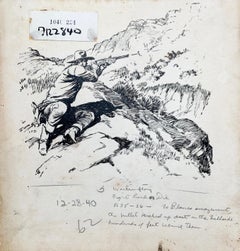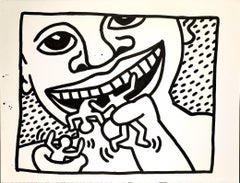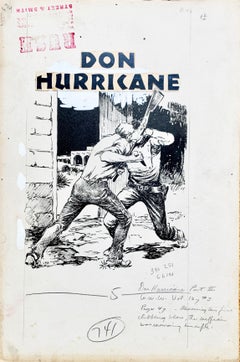Lorence Bjorklund Art
to
2
1
1
2
Overall Height
to
Overall Width
to
2
2
1
1
1
2
1
1
2
6,910
3,230
2,514
1,217
2
Artist: Lorence Bjorklund
Lorence Bjorklund "Trail Bros", ink on illustration board
By Lorence Bjorklund
Located in Glenview, IL
"Trail Bros" by Swedish American pulp artist Lorence Bjorklund (1913 - 1978) is an ink drawing on illustration board representing a western scene som...
Category
1950s Other Art Style Lorence Bjorklund Art
Materials
Ink
Lorence Bjorklund "Fight Back or Die", original ink on illustration board
By Lorence Bjorklund
Located in Glenview, IL
"Fight Back or Die" by Swedish American pulp artist Lorence Bjorklund (1913 - 1978) is an ink drawing on illustration board representing a male figur...
Category
1940s Other Art Style Lorence Bjorklund Art
Materials
Ink
Related Items
Untitled, 1982 (Cannibal)
By Keith Haring
Located in Greenwich, CT
Untitled, 1982 is a sumi ink on paper, 38.25 x 50" image size, signed and dated verso 'SEPT.21 - 82 + K. Haring' and framed in a custom, gold-leaf frame.
Haring’s image of a man-eating monster is partly influenced by the artist Hieronymus Bosch as Haring often cited Bosch’s The Garden of Earthly...
Category
1980s Pop Art Lorence Bjorklund Art
Materials
Paper, Sumi Ink
The Abduction of the Sabine Women , a Renaissance drawing by Biagio Pupini
Located in PARIS, FR
This vigorous drawing has long been attributed to Polidoro da Caravaggio: The Abduction of the Sabine Women is one of the scenes that Polidoro depicted between 1525 and 1527 on the façade of the Milesi Palazzo in Rome. However, the proximity to another drawing inspired by this same façade, kept at the Ecole des Beaux-Arts, and to other drawings inspired by Polidoro kept at the Musée du Louvre, leads us to propose an attribution to Biagio Pupini, a Bolognese artist whose life remains barely known, despite the abundant number of drawings attributed to him.
1. Biagio Pupini, a Bolognese artist in the light of the Roman Renaissance
The early life of Biagio Pupini, an important figure of the first half of the Cinquecento in Bologna - Vasari mentions him several times - is still poorly known. Neither his date of birth (probably around 1490-1495) nor his training are known. He is said to have been a pupil of Francesco Francia (1450 - 1517) and his name appears for the first time in 1511 in a contract with the painter Bagnacavallo (c. 1484 - 1542) for the frescoes of a church in Faenza. He then collaborated with Girolamo da Carpi, at San Michele in Bosco and at the villa of Belriguardo.
He must have gone to Rome for the first time with Bagnacavallo between 1511 and 1519. There he discovered the art of Raphael, with whom he might have worked, and that of Polidoro da Caravaggio. This first visit, and those that followed, were the occasion for an intense study of ancient and modern art, as illustrated by his abundant graphic production.
Polidoro da Caravaggio had a particular influence on the technique adopted by Pupini. Executed on coloured paper, his drawings generally combine pen, brown ink and wash with abundant highlights of white gouache, as in the drawing presented here.
2. The Abduction of the Sabine Women
Our drawing is an adaptation of a fresco painted between 1525 and 1527 by Polidoro da Caravaggio on the façade of the Milesi Palace in Rome. These painted façades were very famous from the moment they were painted and inspired many artists during their stay in Rome. These frescoes are now very deteriorated and difficult to see, as the palace is in a rather narrow street.
The episode of the abduction of the Sabine women (which appears in the centre of the photo above) is a historical theme that goes back to the origins of Rome and is recounted both by Titus Livius (Ab Urbe condita I,13), by Ovid (Fasti III, 199-228) and by Plutarch (II, Romulus 14-19). After killing his twin brother Romus, Romulus populates the city of Rome by opening it up to refugees and brigands and finds himself with an excess of men. Because of their reputation, none of the inhabitants of the neighbouring cities want to give them their daughters in marriage. The Romans then decide to invite their Sabine neighbours to a great feast during which they slaughter the Sabines and kidnap their daughters.
The engraving made by Giovanni Battista Gallestruzzi (1618 - 1677) around 1656-1658 gives us a good understanding of the Polidoro fresco, allowing us to see how Biagio Pupini reworked the scene to extract this dynamic group.
With a remarkable economy of means, Biagio Pupini takes over the left-hand side of the fresco and depicts in a very dense space two main groups, each consisting of a Roman and a Sabine, completed by a group of three soldiers in the background (which seems to differ quite significantly from Polidoro's composition).
The balance of the drawing is based on a very strongly structured composition. The drawing is organised around a median vertical axis, which runs along both the elbow of the kidnapped Sabine on the left and the foot of her captor, and the two main diagonals, reinforced by four secondary diagonals. This diamond-shaped structure creates an extremely dynamic space, in which centripetal movements (the legs of the Sabine on the right, the arm of the soldier on the back at the top right) and centrifugal movements (the arm of the kidnapper on the left and the legs of the Sabine he is carrying away, the arm of the Sabine on the right) oppose each other, giving the drawing the appearance of a whirlpool around a central point of support situated slightly to the left of the navel of the kidnapper on the right.
3. Polidoro da Caravaggio, and the decorations of Roman palaces
Polidoro da Caravaggio was a paradoxical artist who entered Raphael's (1483 - 1520) workshop at a very young age, when he oversaw the Lodges in the Vatican. Most of his Roman work, which was the peak of his career, has disappeared, as he specialised in facade painting, and yet these paintings, which are eminently visible in urban spaces, have influenced generations of artists who copied them abundantly during their visits to Rome.
Polidoro Caldara was born in Caravaggio around 1495-1500 (the birthplace of Michelangelo Merisi, known as Caravaggio, who was born there in 1571), some forty kilometres east of Milan. According to Vasari, he arrived as a mason on the Vatican's construction site and joined Raphael's workshop around 1517 (at the age of eighteen according to Vasari). This integration would have allowed Polidoro to work not only on the frescoes of the Lodges, but also on some of the frescoes of the Chambers, as well as on the flat of Cardinal Bibiena in the Vatican.
After Raphael's death in 1520, Polidoro worked first with Perin del Vaga before joining forces with Maturino of Florence (1490 - 1528), whom he had also known in Raphael's workshop. Together they specialised in the painting of palace façades. They were to produce some forty façades decorated with grisaille paintings imitating antique bas-reliefs.
The Sack of Rome in 1527, during which his friend Maturino was killed, led Polidoro to flee first to Naples (where he had already stayed in 1523), then to Messina. It was while he was preparing his return to the peninsula that he was murdered by one of his assistants, Tonno Calabrese, in 1543.
In his Vite, Vasari celebrated Polidoro as the greatest façade decorator of his time, noting that "there is no flat, palace, garden or villa in Rome that does not contain a work by Polidoro". Polidoro's facade decorations, most of which have disappeared as they were displayed in the open air, constitute the most important lost chapter of Roman art of the Cinquecento. The few surviving drawings of the painter can, however, give an idea of the original appearance of his murals and show that he was an artist of remarkable and highly original genius.
4. The façade of the Milesi Palace
Giovanni Antonio Milesi, who commissioned this palace, located not far from the Tiber, north of Piazza Navona, was a native of the Bergamo area, like Polidoro, with whom he maintained close friendly ties. Executed in the last years before the Sack of Rome, around 1526-1527, the decoration of Palazzo Milesi is considered Polidoro's greatest decorative success.
An engraving by Ernesto Maccari made at the end of the nineteenth century allows us to understand the general balance of this façade, which was still well preserved at the time. The frescoes were not entirely monochrome, but alternated elements in chiaroscuro simulating marble bas-reliefs and those in ochre simulating bronze and gold vases...
Category
16th Century Old Masters Lorence Bjorklund Art
Materials
Ink, Gouache, Pen
I Want Pizza by Daniel Johnston Ink on paper
Located in Austin, US
I Want Pizza by Daniel Johnston
original ink on paper
measures 8.5" x 11"
Est. late 1970s
Signed au recto in ink by the artist
In excellent condition for its age with no rips on the paper
This drawing was part of Power Pathos, a 2006 Station Museum of Contemporary Art (Houston, TX) exhibit showcasing the work of five artists: Ron English, Clark Fox...
Category
Late 20th Century Outsider Art Lorence Bjorklund Art
Materials
Ink
"Frank Sinatra"
By Albert Al Hirschfeld
Located in Lambertville, NJ
Jim's of Lambertville Fine Art Gallery is proud to present this piece by Albert Hirschfeld (1903 – 2003).
At the age of 12, Albert Hirschfeld, the famed caricaturist who depicted figures in the New York theater...
Category
1960s Other Art Style Lorence Bjorklund Art
Materials
Paper, Ink
Untitled (Queen of Hearts with Dog on Leash)
Located in Palm Desert, CA
A drawing by Keith Haring. ""Untitled (Queen of Hearts with Dog on Leash)"" is a figurative drawing, ink on illustration board by American Pop Artist Keith Haring. The artwork is uns...
Category
Mid-20th Century Contemporary Lorence Bjorklund Art
Materials
Ink
Temple in the Garden - Drawing - Early 20th Century
Located in Roma, IT
Temple in the Garden is an original artwork, pencil, watercolor and charcoal on paper. Is not signed and dated but we can attribute the period early 20th Century.
It's an evocative...
Category
Early 20th Century Modern Lorence Bjorklund Art
Materials
Ink, Paper
No Reserve
H 15.75 in W 31.5 in D 0.04 in
"Frank Sinatra and Shirley MacLaine at Radio City Music Hall"
By Albert Al Hirschfeld
Located in Lambertville, NJ
Jim's of Lambertville Fine Art Gallery is proud Albert Hirschfeld (1903 – 2003)
At the age of 12, Albert Hirschfeld, the famed caricaturist who depicted figures in the New York theater...
Category
1960s Other Art Style Lorence Bjorklund Art
Materials
Paper, Ink
Italian Old Master Ink & Wash Drawing St. Anne & The Virgin Mary with Cherubs
Located in Cirencester, Gloucestershire
Pietro Fancelli (Italian 1764 - 1850)
bio details attached to the frame
'St. Anne & The Virgin'
ink with watercolor wash on paper, framed
framed: 22 x 16 inches
image: 11 x 6.5 inche...
Category
Late 18th Century Old Masters Lorence Bjorklund Art
Materials
Watercolor, Ink
Elite Discourse - Drawing by Luigi Bompard - 1920s
Located in Roma, IT
Elite Discourse is a watercolor and ink drawing on ivory-colored paper, in the 1920s realized by Luigi Bompard (1879-1953).
Hand-signed in pen on the lower margin.
In good conditio...
Category
1920s Art Deco Lorence Bjorklund Art
Materials
Ink, Watercolor
H 11.03 in W 8.67 in D 0.08 in
"Medieval Thoughts, Prague, " Alphonse Mucha, Czech Art Nouveau Illustration
By Alphonse Mucha
Located in New York, NY
Alphonse Mucha (Czech, 1860 - 1939)
Medieval Thoughts, circa 1890
Wash, ink, and watercolor on paper
11 x 9 inches
Signed lower right
Provenance:
Phillips New York, 19th and 20th ce...
Category
1890s Art Nouveau Lorence Bjorklund Art
Materials
Watercolor, Ink, Paper
Musiciens Sur Fond Multicolore By Marc Chagall
By Marc Chagall
Located in New Orleans, LA
Marc Chagall
1887-1985 Russian
Musiciens sur fond multicolore
(Musicians on a multicolored background)
Signed 'Chag' (on the sleeve of the right figure); stamped with the signature 'Marc Chagall' (lower right)
Tempera, gouache, colored ink and India ink and pastel on paper
“The fact that I made use of cows, milkmaids, roosters and provincial Russian architecture as my source forms is because they are part of the environment from which I spring and which undoubtedly left the deepest impression on my visual memory of the experiences I have." - Marc Chagall
Marc Chagall’s 1981...
Category
20th Century Post-Impressionist Lorence Bjorklund Art
Materials
Paper, Pastel, Ink, India Ink, Tempera, Gouache
Personnages
By Alexander Calder
Located in Palm Desert, CA
"Personnages" is a gouache on paper by Alexander Calder. The work is signed in the lower right, "Calder 67".
Although renowned for his innovative and groundbreaking sculptures, Alex...
Category
1960s Lorence Bjorklund Art
Materials
Ink, Paper, Gouache
Previously Available Items
Lorence Bjorklund "Trail of the horse", original ink on illustration board
By Lorence Bjorklund
Located in Glenview, IL
"Trail of the horse" by Swedish American pulp artist Lorence Bjorklund (1913 - 1978) is an ink drawing on illustration board representing two horseback riding male figures surveying ...
Category
1940s Other Art Style Lorence Bjorklund Art
Materials
Ink
Lorence Bjorklund "Don Hurricane", original ink on illustration board
By Lorence Bjorklund
Located in Glenview, IL
"don Hurricane" by Swedish American pulp artist Lorence Bjorklund (1913 - 1978) is an ink drawing on illustration board representing two fighting mal...
Category
1940s Other Art Style Lorence Bjorklund Art
Materials
Ink
H 15 in W 10 in D 0.2 in
Lorence Bjorklund "The Whistlin' Kids ... Trail", ink on illustration board
By Lorence Bjorklund
Located in Glenview, IL
"The Whistlin' Kids (illegible) Trail " by Swedish American pulp artist Lorence Bjorklund (1913 - 1978) is an ink drawing on illustration board repre...
Category
1940s Other Art Style Lorence Bjorklund Art
Materials
Ink
Lorence Bjorklund "Sonny Tabor's Silver Handcuffs", ink on illustration board
By Lorence Bjorklund
Located in Glenview, IL
"Sonny Tabor's Silver Handcuffs" by Swedish American pulp artist Lorence Bjorklund (1913 - 1978) is an ink drawing on illustration board representing...
Category
1940s Other Art Style Lorence Bjorklund Art
Materials
Ink
Lorence Bjorklund "Gold Robbers of Cutthroat Gulch", ink on illustration board
By Lorence Bjorklund
Located in Glenview, IL
"Gold Robbers of Cutthroat Gulch" by Swedish American pulp artist Lorence Bjorklund (1913 - 1978) is an ink drawing on illustration board representin...
Category
1940s Other Art Style Lorence Bjorklund Art
Materials
Ink
Lorence Bjorklund "Secret of Cedar Brook", original ink on illustration board
By Lorence Bjorklund
Located in Glenview, IL
"Secret of Cedar Brook" by Swedish American pulp artist Lorence Bjorklund (1913 - 1978) is an ink drawing on illustration board representing two male...
Category
1940s Other Art Style Lorence Bjorklund Art
Materials
Ink
Lorence Bjorklund "Smokey Serenade", ink on illustration board
By Lorence Bjorklund
Located in Glenview, IL
"Smokey Serenade" by Swedish American pulp artist Lorence Bjorklund (1913 - 1978) is an ink drawing on illustration board representing two scenes: in...
Category
1950s Other Art Style Lorence Bjorklund Art
Materials
Ink
H 15 in W 10 in D 0.2 in
Lorence Bjorklund "The Sheriff of Powder Rock", ink on illustration board
By Lorence Bjorklund
Located in Glenview, IL
"The Sheriff of Powder Rock" by Swedish American pulp artist Lorence Bjorklund (1913 - 1978) is an ink drawing on illustration board representing the captu...
Category
1950s Other Art Style Lorence Bjorklund Art
Materials
Ink
H 13.25 in W 10 in D 0.2 in
Lorence Bjorklund "Death Throws a Wide Loop", ink on illustration board
By Lorence Bjorklund
Located in Glenview, IL
"Death Throws a Wide Loop" by Swedish American pulp artist Lorence Bjorklund (1913 - 1978) is an ink drawing on illustration board representing a the...
Category
1950s Other Art Style Lorence Bjorklund Art
Materials
Ink
Lorence Bjorklund "A Gun Lawyer for CJ", ink on illustration board
By Lorence Bjorklund
Located in Glenview, IL
"A Gun Lawyer for CJ" by Swedish American pulp artist Lorence Bjorklund (1913 - 1978) is an ink drawing on illustration board representing what appears to be a gun battle under a via...
Category
1950s Other Art Style Lorence Bjorklund Art
Materials
Ink
H 15 in W 10 in D 0.2 in
Lorence Bjorklund "Shawn of the Gun Pack", ink on illustration board
By Lorence Bjorklund
Located in Glenview, IL
"Shawn of the Gun Pack" by Swedish American pulp artist Lorence Bjorklund (1913 - 1978) is an ink drawing on illustration board representing a shoot-...
Category
1950s Other Art Style Lorence Bjorklund Art
Materials
Ink
Lorence Bjorklund "Firebrand's Brothill Bounty", ink on illustration board
By Lorence Bjorklund
Located in Glenview, IL
"Firebrand's Brothill Bounty" by Swedish American pulp artist Lorence Bjorklund (1913 - 1978) is an ink drawing on illustration board representing a ...
Category
1950s Other Art Style Lorence Bjorklund Art
Materials
Ink
Lorence Bjorklund art for sale on 1stDibs.
Find a wide variety of authentic Lorence Bjorklund art available for sale on 1stDibs. You can also browse by medium to find art by Lorence Bjorklund in ink and more. Not every interior allows for large Lorence Bjorklund art, so small editions measuring 9 inches across are available. Customers who are interested in this artist might also find the work of Pierre Segogne, Maxime Juan, and Serge Fontinsky. Lorence Bjorklund art prices can differ depending upon medium, time period and other attributes. On 1stDibs, the price for these items starts at $145 and tops out at $259, while the average work can sell for $245.





